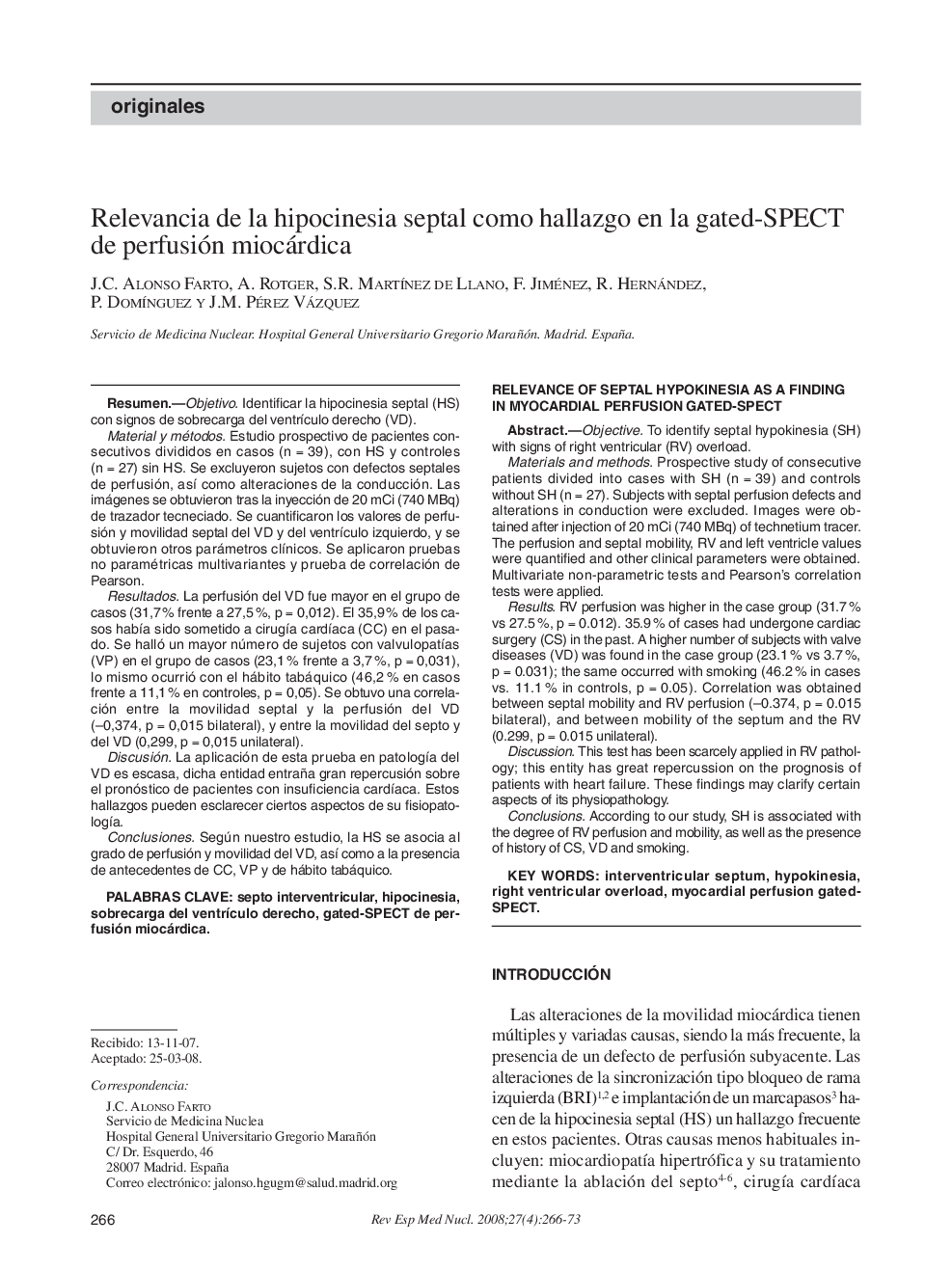| Article ID | Journal | Published Year | Pages | File Type |
|---|---|---|---|---|
| 4249205 | Revista Española de Medicina Nuclear | 2008 | 8 Pages |
ResumenObjetivoIdentificar la hipocinesia septal (HS) con signos de sobrecarga del ventrículo derecho (VD).Material y métodosEstudio prospectivo de pacientes consecutivos divididos en casos (n = 39), con HS y controles (n = 27) sin HS. Se excluyeron sujetos con defectos septales de perfusión, así como alteraciones de la conducción. Las imágenes se obtuvieron tras la inyección de 20 mCi (740 MBq) de trazador tecneciado. Se cuantificaron los valores de perfusion y movilidad septal del VD y del ventrículo izquierdo, y se obtuvieron otros parámetros clínicos. Se aplicaron pruebas no paramétricas multivariantes y prueba de correlación de Pearson.ResultadosLa perfusión del VD fue mayor en el grupo de casos (31,7 % frente a 27,5 %, p = 0,012). El 35,9 % de los casos había sido sometido a cirugía cardíaca (CC) en el pasado. Se halló un mayor número de sujetos con valvulopatías (VP) en el grupo de casos (23,1 % frente a 3,7 %, p = 0,031), lo mismo ocurrió con el hábito tabáquico (46,2 % en casos frente a 11,1 % en controles, p = 0,05). Se obtuvo una correlación entre la movilidad septal y la perfusión del VD (−0,374, p = 0,015 bilateral), y entre la movilidad del septo y del VD (0,299, p = 0,015 unilateral).DiscusiónLa aplicación de esta prueba en patología del VD es escasa, dicha entidad entraña gran repercusión sobre el pronóstico de pacientes con insuficiencia cardíaca. Estos hallazgos pueden esclarecer ciertos aspectos de su fisiopatología.ConclusionesSegún nuestro estudio, la HS se asocia al grado de perfusión y movilidad del VD, así como a la presencia de antecedentes de CC, VP y de hábito tabáquico.
ObjectiveTo identify septal hypokinesia (SH) with signs of right ventricular (RV) overload.Materials and methodsProspective study of consecutive patients divided into cases with SH (n = 39) and controls without SH (n = 27). Subjects with septal perfusion defects and alterations in conduction were excluded. Images were obtained after injection of 20 mCi (740 MBq) of technetium tracer. The perfusion and septal mobility, RV and left ventricle values were quantified and other clinical parameters were obtained. Multivariate non-parametric tests and Pearson's correlation tests were applied.ResultsRV perfusion was higher in the case group (31.7% vs 27.5 %, p = 0.012). 35.9 % of cases had undergone cardiac surgery (CS) in the past. A higher number of subjects with valve diseases (VD) was found in the case group (23.1 % vs 3.7 %, p = 0.031); the same occurred with smoking (46.2 % in cases vs. 11.1% in controls, p = 0.05). Correlation was obtained between septal mobility and RV perfusion (−0.374, p = 0.015 bilateral), and between mobility of the septum and the RV (0.299, p = 0.015 unilateral).DiscussionThis test has been scarcely applied in RV pathology; this entity has great repercussion on the prognosis of patients with heart failure. These findings may clarify certain aspects of its physiopathology.ConclusionsAccording to our study, SH is associated with the degree of RV perfusion and mobility, as well as the presence of history of CS, VD and smoking.
